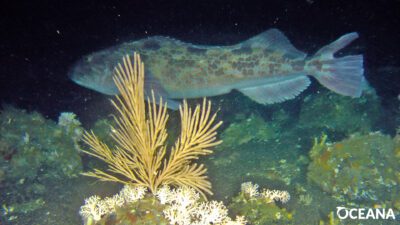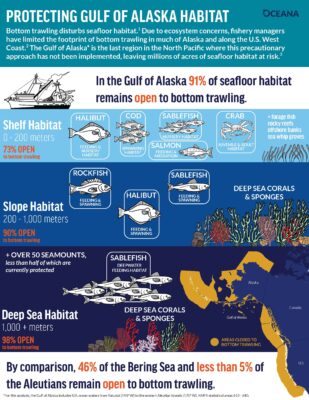Gulf of Alaska Habitat Protection

TAKE ACTION!! Add your name to our petition to protect corals and other seafloor habitat in the Gulf of Alaska!
Click here to learn about on our work to reduce chum salmon bycatch.
Click here for information on our lawsuits around bycatch and the Freedom of Information Act.
To protect seafloor habitat, fishery managers have limited the footprint of bottom trawling in much of Alaska and along the U.S. West Coast, but the Gulf of Alaska* is the last region in the North Pacific where this precautionary approach has not been implemented. Discover more below about our campaign to protect habitat in the Gulf of Alaska below:
Check out our interactive storymap about protecting seafloor habitats in the Gulf of Alaska!
View our factsheet showing the gap in protections for important seafloor habitat in the Gulf of Alaska.
Download a copy of Oceana’s Gulf of Alaska Seafloor Habitat Protection Proposal Discussion Draft, submitted to the North Pacific Fishery Management Council to establish protections for corals, sponges, and other essential habitat features in the central and western Gulf of Alaska.
View our Report, Net Loss: The Cost of Bottom Trawling in the Gulf of Alaska
(Higher resolution version available here)
In May of 2022, Oceana conducted an expedition to document corals and other seafloor habitats in the Gulf of Alaska seafloor to support our campaign to protect these areas from destructive bottom trawling. Throughout the expedition, we found a Gulf of Alaska teeming with life from the surface to the seafloor. Here are some highlights:
Gulf of Alaska Expedition from Oceana on Vimeo.
Our oceans face many threats including climate change, pollution, overfishing, bycatch, habitat destruction, and other human impacts. All of these put extreme stress on marine ecosystems.

The cold and remote waters of the Gulf of Alaska are no exception; yet there is one human-caused threat that has a practical solution that has already been applied to most in the U.S. and Canadian waters from the U.S. Arctic to Southern California: freezing the footprint of bottom trawling.
Bottom trawling is a type of fishing where huge nets are dragged for miles along the seafloor to catch flatfish like flounder or sole. Yet trawl nets also destroy ancient corals and other important habitats as they catch everything in their path. This habitat destruction has cascading impacts to fish and other sea life, ultimately threatening ocean ecosystems.

According to the National Academy of Sciences, bottom trawling is the most destructive form of fishing on seafloor habitat like corals and sponges. In addition to harming seafloor habitat, bottom trawlers in Alaska catch and often waste nontargeted salmon, halibut, crab and other species central to the lives of Alaskans. The Gulf of Alaska is the last place on the U.S. west coast where industrial bottom trawling can still be conducted in large areas of corals and other ocean habitats vital for fish and other animals.

However, there is a solution, one that has been implemented throughout much of the North Pacific. Oceana has worked with fishery managers, fishermen, indigenous communities, and other organizations to save seafloor habitat through a “freeze the footprint” approach to bottom trawling. In this approach, bottom trawling can only continue in areas that have already been trawled, protecting new areas from being destroyed and ensuring untrawled, vibrant habitats remain intact. The freeze the footprint approach also protects key seafloor habitats within the existing footprint such as coral gardens, seamounts, canyon heads, rocky reefs, and sponge beds.
Along with limiting bycatch and protecting important ecological areas within the trawl footprint, this approach represents a win-win for healthy fisheries and healthy oceans. It’s time to implement this same approach in the Gulf of Alaska.
*For our analysis, the Gulf of Alaska includes U.S. ocean waters from Yakutat (140° W) to the eastern Aleutian Islands (170° W), NMFS statistical areas 610 – 640





